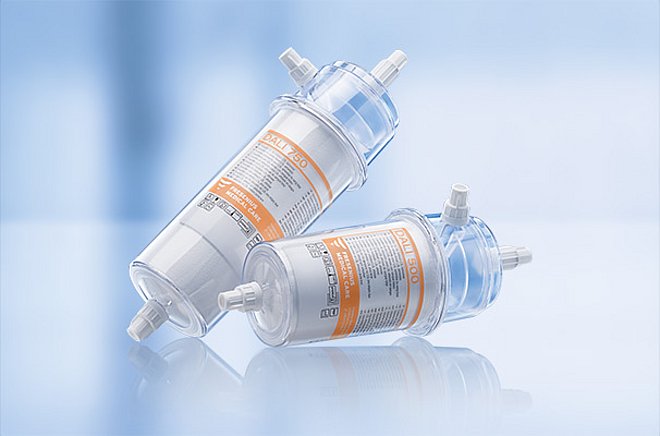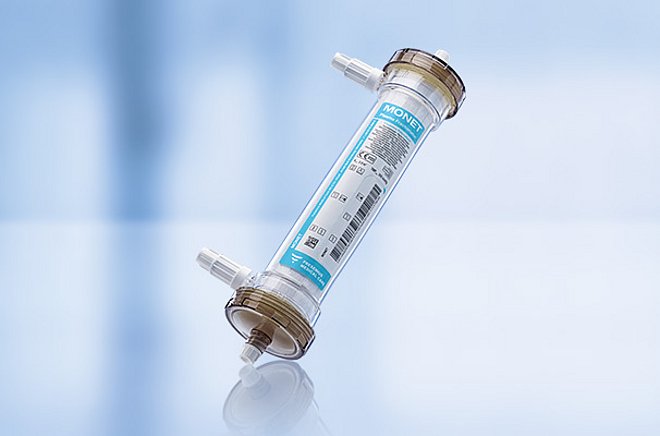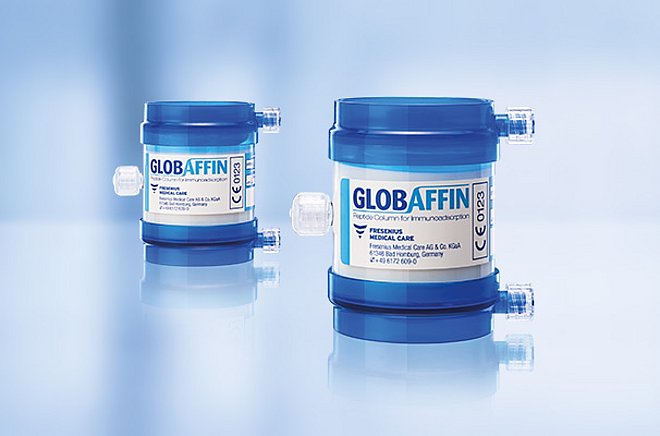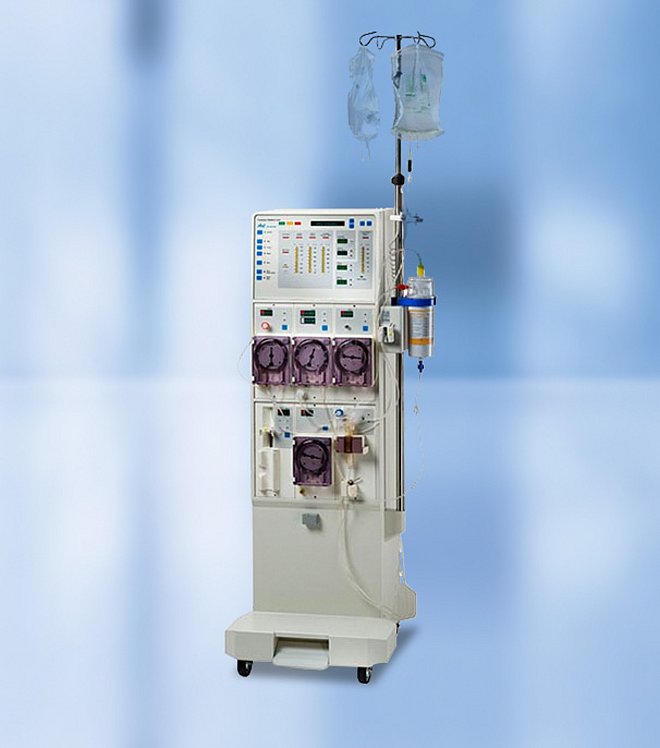Heart and cardiology
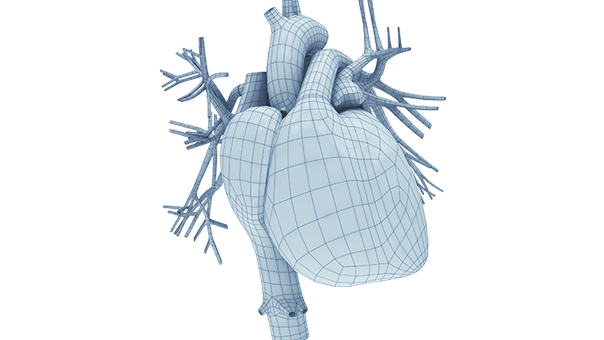
Cardiology-related clinical indications
In the field of cardiology, therapeutic apheresis techniques can be used to treat some very challenging and important clinical indications. For some indications, the efficacy of therapeutic apheresis is already well established; for others, studies are currently underway. By far the most extensive experience has been gained using lipoprotein apheresis. Meanwhile, the use of immunoadsorption to treat dilatative cardiomyopathy remains a prominent topic. A new indication is the reduction of C-reactive protein after myocardial infarction. Fresenius Medical Care is working on this area in partnership with the Berlin-based company Pentracor.
Hyperlipidemia
Cardiovascular (CV) diseases are the most frequent cause of death in people under 75 years of age.1 Two major CV risk factors are hypercholesterolemia and elevated levels of lipoprotein(a) [Lp(a)]. Familial hypercholesterolemia (FH) and hyper-Lp(a)-emia are genetic disorders characterised by high low-density lipoprotein (LDL-C) and high Lp(a) blood levels, leading to early CV events due to enhanced atherosclerosis. The prevalence of homozygous FH (HoFH) is between 1:160,000 and 1:300,000; that of the heterozygous form (HeFH) is between 1:200 and 1:250.2 For patients with very high CV risk, target levels for LDL-C are below 70 mg/dL (1.8 mmol/L) and, for Lp(a), below 50 mg/dL, according to European (ESC/EAS) guidelines.3
Lipoprotein apheresis is a treatment of choice for homozygous, severe hypercholesterolaemic and hyper-Lp(a) patients when dietary measures and drug treatment prove insufficient to achieve target levels of LDL-C and Lp(a). In such circumstances, lipoprotein apheresis can reduce CV risk.
Dilated cardiomyopathy
Dilated cardiomyopathy (DCM) is a disease of the heart muscle and causes the heart to lose its ability to pump blood efficiently. It is one of the most frequent myocardial diseases. In about a quarter of all DCM cases, the cause of disease is unclear (idiopathic). It is with reference to these cases that autoantibodies are currently being discussed as the cause. More specifically, the autoantibodies directed against the ß1-adrenergic receptor may play a causal role in the pathogenesis of idiopathic DCM. In numerous studies, more than 60% of patients treated with a single course of five immunoadsorption sessions showed significant improvement in their cardiac performance.4,5 In order to investigate immunoadsorption as a causal therapy for autoimmune DCM, a multi-centre prospective study is now underway in more than 20 European hospitals.
Chagas cardiomyopathy
Chagas disease is caused by the parasite Trypanosoma cruzi, which insect vectors transmit to animals and people. Between 16 and 18 million people are affected by the diesease, which is primarily found in the Americas. Following the acute phase, most of those infected enter a prolonged, asymptomatic phase, during which few or no parasites are found in the blood. Many patients may remain asymptomatic for life and never develop Chagas-related symptoms. However, an estimated 20–30% of infected people will develop debilitating and sometimes life-threatening medical problems over their lifetime. These complications may include heart rhythm abnormalities or Chagas cardiomyopathy. The latter is associated with agonistic autoantibodies related to the IgG type.6 Beyond standard therapy, immunoadsorption with GLOBAFFIN may offer an additional option. This theory is the subject of a current clinical investigation.
Myocardial infarction
A massive release of C-reactive protein tends to be imminient following cases of ST-elevated myocardial infarction. In this context, CRP is deemed to organise the fibrotic remodelling of heart tissue, leading to a greater “scar” in the follow-up period. The use of selective immunoadsorption to radically reduce CRP directly after a myocardial infarction event is therefore currently under consideration as a measure to alleviate scarring and ejection fraction loss, as well as reduce the likelihood of re-infarction. These outcome parameters are subject to a current clinical study taking place across Germany. In this regard, Fresenius Medical Care is working in partnership with the Berlin-based company Pentracor.
Other indications
In addition to previously mentioned indications, the following are also potentially of interest in terms of being treated with adsorption techniques:
- Diabetic cardiomyopathy7
- Pulmonary hypertension8
1 European Cardiovascular Disease Statistics slide 1.2a and 1.2b, page 20; 2017 Edition; www.ehnheart.org; 07 April 2017
2 Catapano AL et al, Atherosclerosis Oct. 2016; 253: 281–344.
3 Nordestgaard BG et al, Lipoprotein(a): EAS Recommendations for Screening, Desirable Levels and Management, A Handbook for Clinicians, 2012.
4 Doesch et al, Effects of protein A immunoadsorption in patients with chronic dilated cardiomyopathy. Journal of Clinical Apheresis 2010; 25(6): 315–22.
5 Staudt et al, Fcγ-Receptor IIa Polymorphism and the Role of Immunoadsorption in Cardiac Dysfunction in Patients with Dilated Cardiomyopathy. Clinical Pharmacology & Therapeutics 2010; 87(4): 452–8.
6 Wallukat et al, Distinct patterns of autoantibodies against G-protein-coupled receptors in Chagas' cardiomyopathy and megacolon. Their potential impact for early risk assessment in asymptomatic Chagas' patients. Journal of the American College of Cardiology 2 February 2010; 55(5): 463–8.
7 Dandel et al, lmmunoadsorption can improve cardiac function in transplant candidates with non-ischemic dilated cardiomyopathy associated with diabetes mellitus. Atherosclerosis Supplements 2015; 18: 124–33.
8 Dandel et al, Immunoadsorption therapy for dilated cardiomyopathy and pulmonary arterial hypertension. Atherosclerosis Supplements 2013; 14: 203–11
